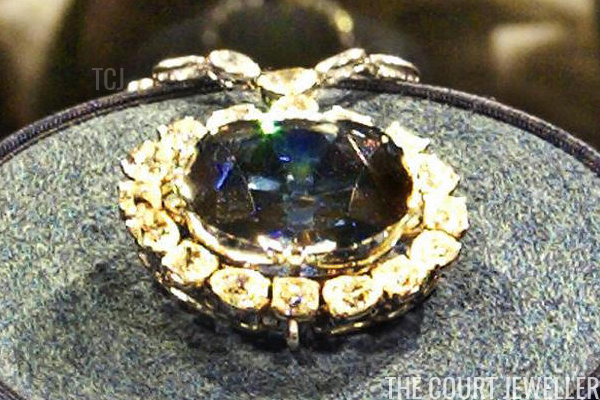 |
| PAUL J. RICHARDS/AFP via Getty Images |
One of the most fascinating gems in the world, the Hope Diamond, has been on display at the Smithsonian’s Natural History Museum in Washington, D.C., for more than half a century. Today, we’ve got a look at the diamond in the museum’s exhibition, including two of its most famous settings — in motion!

A very quick history lesson: the gem we now call the Hope Diamond was likely the blue diamond bought by Jean Baptiste Tavernier in the seventeenth century. Tavernier sold the diamond, which likely came from Golconda in India, to King Louis XIV in 1668. The stone, then called the “French Blue,” was stolen during the French Revolution in September 1792. The diamond was then recut.

In the 1830s it surfaces in the inventory of Henry Philip Hope — hence the diamond’s best-known name. It was sold by Hope’s descendants in 1901, and in 1911, it caught the eye of an American socialite, Evalyn Walsh McLean. She owned the diamond until her death in 1947, when it was purchased by Harry Winston, Inc.

During McLean’s tenure as the diamond’s owner, she had it placed in the familiar cluster setting so many of us recognize today. She used the diamond as a pendant on a necklace, and she often suspended some of her other fantastic gems, including the pear-shaped, 94-carat “Star of the East” Diamond, from the Hope.

The Smithsonian has primarily displayed the Hope Diamond in the McLean pendant setting since its arrival in the museum’s collection. Harry Winston donated the stone to the Smithsonian in November 1958, and since then, it has mainly resided in the National Museum of Natural History. The setting features sixteen white diamonds clustered around the Hope, including both pear-shaped and cushion-cut stones.

Occasionally, the museum has removed the Hope from its pendant setting. In 1974, the stone was removed so that it could be carefully assessed; that examination noted that the stone weighs 45.52 carats. The blue stone is a type IIb diamond, making it one of the rarest gems in the world. (Only .1% of diamonds are type IIb.)

The Smithsonian notes that type IIb diamonds, like the Hope, “are semiconductive and usually phosphoresce. The Hope diamond phosphoresces a strong red color, which will last for several seconds after exposure to short wave ultra-violet light.”

Here’s another view of the Hope’s red phosphorescence, which many believe may have helped to fuel the idea that the Hope is “cursed.” (We explored the “curse” over here!)

In 2009, visitors to the Smithsonian got the rare chance to view the “naked” Hope Diamond, which had been removed from its setting and exhibited alone for the first time at the museum. It was placed back in its usual pendant setting in 2010.

Later that year, however, the Hope’s setting was changed once more. The museum unveiled a brand-new setting for the diamond, which had been created by Harry Winston. The modern “Embracing Hope” necklace featured 340 baguette diamonds hugging the Hope.

The new necklace setting was a temporary one. It made its debut at the museum on November 18, 2010.
 |
| PAUL J. RICHARDS/AFP via Getty Images |
Here’s one more view of the Hope in the newer, modern setting. Those who visit the museum today won’t see the Hope in this format. It was returned to its traditional pendant setting in January 2012.
Have you had the chance to see the Hope Diamond in person at the Smithsonian? Which setting do you prefer: the pendant, the modern necklace, or no setting at all?
Leave a Reply